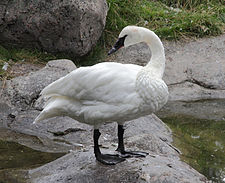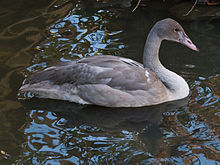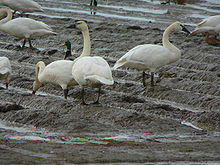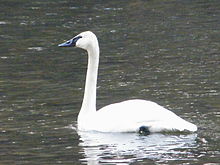- Trumpeter Swan
-
Trumpeter Swan 
Conservation status Scientific classification Kingdom: Animalia Phylum: Chordata Class: Aves Order: Anseriformes Family: Anatidae Subfamily: Anserinae Tribe: Cygnini Genus: Cygnus Species: C. buccinator Binomial name Cygnus buccinator
Richardson, 1832The Trumpeter Swan, Cygnus buccinator, is the largest native North American bird, if measured in terms of weight and length, and is (on average) the largest living waterfowl species on earth. It is the North American counterpart of the European Whooper Swan.
Contents
Description
Males (also known as Cobs) typically measure from 145 to 170 cm (57 to 67 in) and weigh 11–14.5 kg (24–32 lb); females typically range from 139 to 160 cm (55 to 63 in) and weigh 9–11 kg (20–24 lb). A series of adult Trumpeters of both sexes were found to have a mean weight of 10.8 kg (24 lb).[2] The wingspan is typically in the range of 2.03–2.6 m (6.7–8.5 ft).[3][4] It is rivaled in size among waterfowl only by the Mute Swan, which is native to Eurasia but has been introduced to North America, although the Trumpeter usually is slightly larger in linear measurements. Exceptionally large male Trumpeters can reach a length of 183 cm (72 in), a wingspan of 3.05 m (10.0 ft) and a weight of 17.2 kilograms (38 lb).[5] The Trumpeter Swan is closely related to the Whooper Swan of Eurasia, and even has been considered the same species by some authorities.
The cygnets (juveniles) are grey in appearance, becoming white after the first year. The Mute Swan can easily be distinguished by its orange bill and different structure (particularly the neck, which is almost always curved down). The Tundra Swan more closely resembles the Trumpeter, but is quite a bit smaller and usually has yellow lores. Although extremely rare, Trumpeter Swans have been known to have yellow lores. Distinguishing Tundra and Trumpeter Swans from a distance (when size is harder to gauge) is quite challenging, and can often be done only with experience and knowledge of structural details.
Range and habitat
Their breeding habitat is large shallow ponds and wide slow rivers in northwestern and central North America, with the largest numbers of breeding pairs found in Alaska. Natural populations of these swans migrate to and from the Pacific coast and portions of the United States, flying in V-shaped flocks. Released populations are mostly non-migratory. In the winter they migrate to the southern tier of Canada, the eastern part of the northwest states in the United States, especially to the Red Rock Lakes area of Montana, the north Puget Sound region of northwest Washington state;[6] they have even been observed as far south as Pagosa Springs, Colorado. Historically they range as far south as Texas and southern California.[7]
These birds feed while swimming, sometimes up-ending or dabbling to reach submerged food. The diet is almost entirely aquatic plants. In winter, they may also eat grasses and grains in fields. The young are fed on insects and small crustaceans along with plants at first, changing to a vegetation-based diet over the first few months. Predators of Trumpeter Swan eggs include Common Raven (Corvus corax), Common Raccoon (Procyon lotor), Wolverine (Gulo gulo), American Black Bear (Ursus americanus), Brown Bear (Ursus arctos), Coyote (Canis latrans), Gray Wolf (Canis lupus) and Northern River Otter (Lontra canadensis). Most of the same predators will prey on young cygnets, as will Common Snapping Turtle (Chelhydra serpentina), California Gull (Larus californicus), Great Horned Owl (Bubo virginianus) and American Mink (Mustela vison). Larger cygnets and nesting adults are preyed on by Golden Eagle (Aquila chrysaetos), Bobcat (Lynx rufus), Red Fox (Vulpes vulpes) and Coyote. Few predators, apart from the Bobcat and possibly the Golden Eagle, are capable of taking adults when they are not nesting.
Breeding
The female lays 3-12 eggs on average in a mound of plant material on a small island, a beaver or muskrat lodge, or a floating platform. The same location may be used for several years. The eggs average 73 millimetres (2.9 in) wide, 113.5 millimetres (4.5 in) long, and weigh about 320 grams (11.3 oz). The incubation period is 32 to 37 days. These birds often mate for life, and both parents will participate in raising the cygnets, but only the female will incubate the eggs. The young are able to swim within two days and usually are capable of feeding themselves after at most two weeks. The fledging stage is reached at 3 to 4 months.[8]
Adults go through a summer moult when they temporarily lose their flight feathers. The females become flightless shortly after the young hatch; the males go through this process about a month later when the females have completed their moult.
Conservation status
In the 19th and early 20th centuries, the Trumpeter Swan was hunted heavily, both as game and a source of feathers. This species is also unusually sensitive to lead poisoning while young. These birds once bred in North America from northwestern Indiana west to Oregon in the U.S., and in Canada from James Bay to the Yukon, and they migrated as far south as Texas and southern California.[7] The trumpeter was rare or extinct in most of the United States by the early twentieth century.[7] Many thousands survived in the core range in Canada and Alaska, however, where populations have since rebounded.
Early efforts to reintroduce this bird into other parts of its original range, and to introduce it elsewhere, have had only modest success, as suitable habitats have dwindled and the released birds do not undertake migrations. More recently, the population in all three major population regions have shown sustained growth over the past thirty year period. Data from the US Fish and Wildlife Service[9] show 400% growth in that period, with signs of increasing growth rates over time.
One impediment to the growth of the Trumpeter Swan population around the Great Lakes is the presence of a growing non-migratory Mute Swan population who compete for habitat.[10][11]
The Toronto Zoo started a conservation project in 1982, using eggs collected in the wild. Live birds have also been taken from the wild. Since then more than 180 have been released in Ontario. Despite lead poisoning in the wild from shotgun pellets, the prospects for restoration are considered good.[12]
The Trumpeter Swan is listed as threatened in the state of Minnesota.[13]
See also
- Grande Prairie 'Swan City'
- Ralph Edwards, a leading Canadian conservationist of trumpeter swans
References
- ^ IUCN: Cygnus buccinator
- ^ [1] (2011).
- ^ Allaboutbirds.org
- ^ Ogilvie & Young, Wildfowl of the World. New Holland Publishers (2004), ISBN 978-1843303282
- ^ Wood, Gerald (1983). The Guinness Book of Animal Facts and Feats. ISBN 978-0-85112-235-9.
- ^ Washington State University Beach Watchers; "...Trumpeter Swans..."
- ^ a b c Joseph Grinnell, Harold Child Bryant, Tracy Irwin Storer (1918). The Game Birds of California. University of California Press. p. 254. http://books.google.com/books?id=wcTPAAAAMAAJ&pg=PA253&lpg=PA253&dq=grinnell+trumpeter+swan#v=onepage&q=grinnell%20trumpeter%20swan&f=false. Retrieved 2010-08-18.
- ^ "Trumpeter Swan Fact Sheet, Lincoln Park Zoo"
- ^ U.S. Fish and Wildlife Service: T. J. Moser. 2005 North American Trumpeter Swan Survey.
- ^ Trumpeter Swan
- ^ Mute Swan
- ^ "Toronto Zoo > Conservation > Birds". http://www.torontozoo.com/conservation/birds.asp. Retrieved 2009-09-22.
- ^ Minnesota Endangered & Threatened Species List
External links
- BirdLife Species Factsheet
- Trumpeter Swan Species Account - Cornell Lab of Ornithology
- Trumpeter Swan - Cygnus buccinator - USGS Patuxent Bird Identification InfoCenter
- Trumpeter Swan Information and Photos - South Dakota Birds and Birding
- Trumpeter Swan Wildlife Notebook - Alaska Department of Fish and Game
- The only Trumpeter Swan at The Wolseley Centre - Wolseley Wildlife
- Trumpeter Swan videos,photos and sounds on the Internet Bird Collection
- WSU Beachwatchers - "Winter Visitors Arrive Trumpeter Swans again feeding in the fields"
Categories:- IUCN Red List least concern species
- Cygnus
- Swans
- Birds of North America
Wikimedia Foundation. 2010.







